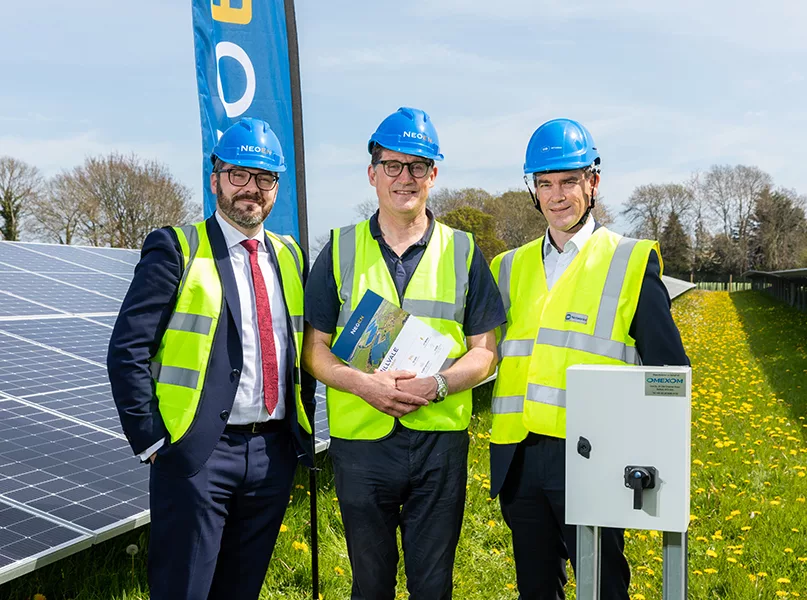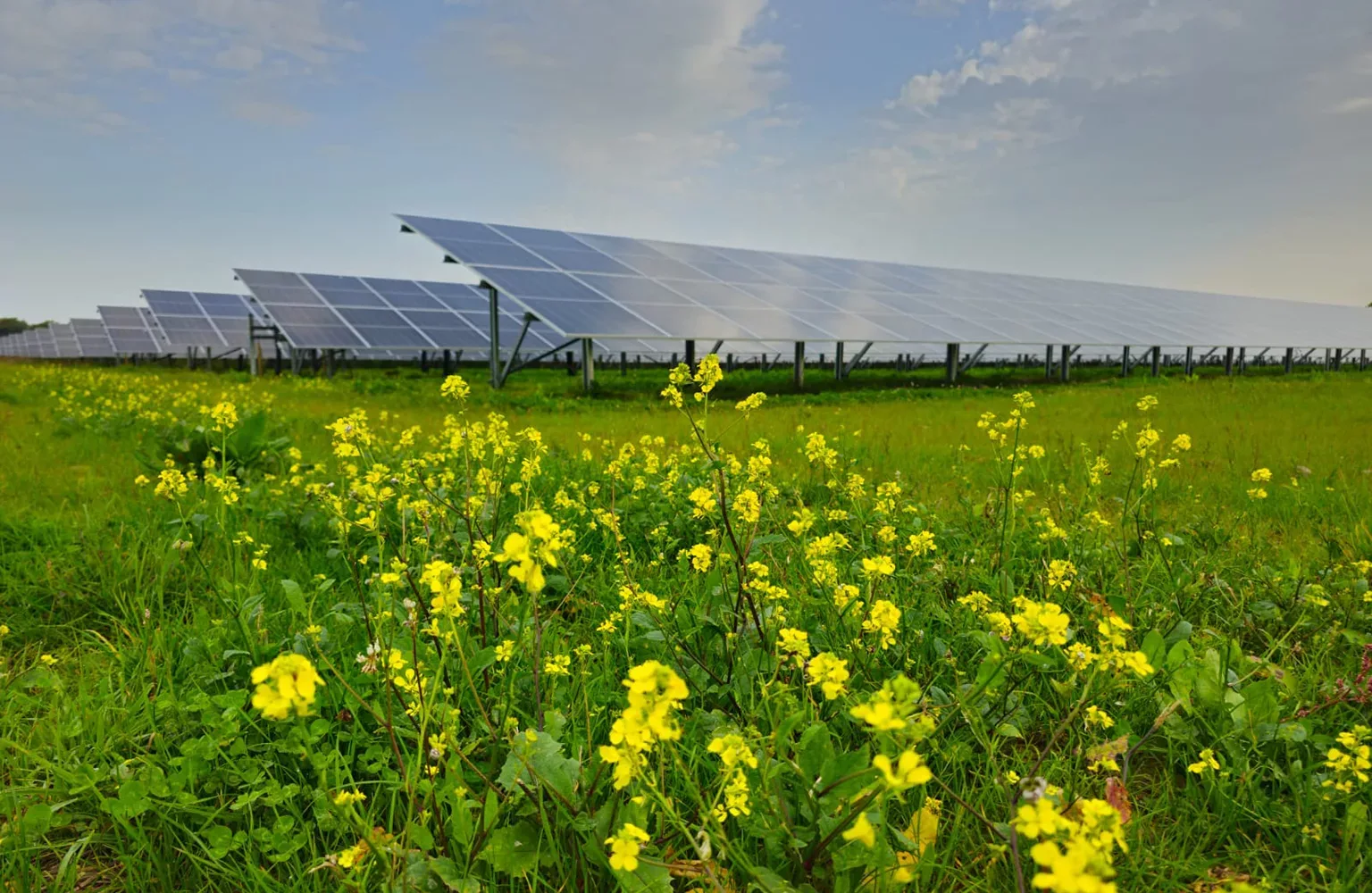As part of its commitment to increasing the generation of renewable electricity, the Irish government has significantly upgraded its 2030 solar PV capacity targets.
SPOTLIGHT ON SOLAR ENERGY IN IRELAND
Ireland has set a target for 80 percent of its electricity to be generated from renewable sources by 2030.
One such renewable source is solar energy, with the Irish government subsequently increasing its solar PV capacity targets from 2.5 gigawatts (GW) to 5GW by 2025 and 8GW by the end of the decade.
This lofty ambition exemplifies the shift of solar energy from a fringe technology to a crucial component of Ireland’s renewable transition. The promise of solar in reshaping Ireland’s energy mix was demonstrated in 2022 when the country’s first utility-scale solar farm developed under the Irish government’s Renewable Energy Support Scheme (RESS) was connected to the national grid. It was a record year for renewable generation capacity, with 616 megawatts (MW) connected to the grid at the end of 2022.
However, there is still a significant amount of work that remains to be done regarding solar microgeneration and commercial projects, and solar development in Ireland is not without its challenges.
For example, there are high costs associated with developing solar projects in Ireland, such as connection costs that are, on average, greater than those in many other European countries.
Other challenges include planning process delays, electricity network upgrades, and the need for storage technology investment.
Roughly 25 percent of solar projects that were successful in the first RESS auction in 2020 are now not progressing. If solar is to play its part in achieving the Irish government’s overarching 80 percent renewable electricity target, such issues need to be minimised to ensure that as many projects as possible progress to completion.
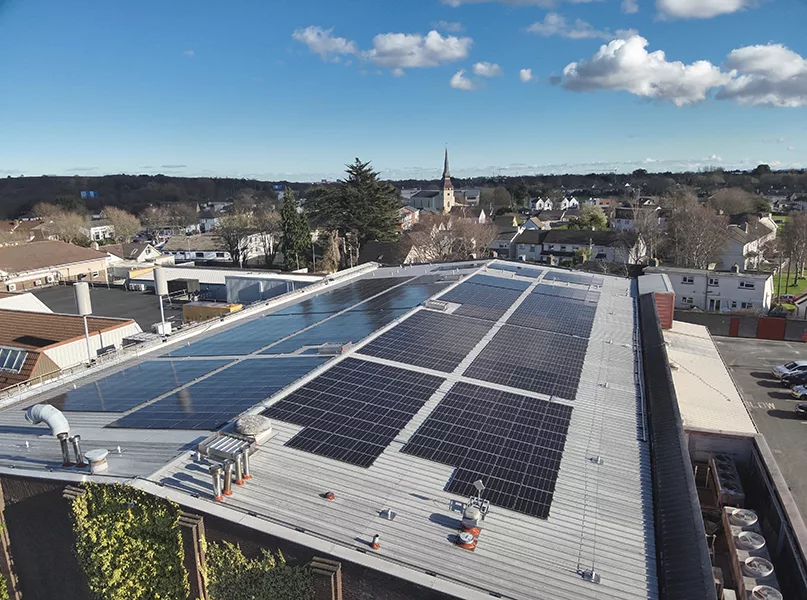
Q&A WITH CONALL BOLGER, CEO, IRISH SOLAR ENERGY ASSOCIATION
With a vision for a fully decarbonised electricity system, Conall Bolger, CEO of the Irish Solar Energy Association, discusses pushing the energy transition forward and how solar will meet the Irish government’s upgraded 2030 electricity capacity targets
Firstly, could you talk us through the origins of the Irish Solar Energy Association – when was it founded, and what is your mission?
Conall Bolger, CEO (CB): The Irish Solar Energy Association was founded by seven companies in May 2013, and I’d say a lot has changed in the intervening decade. We’re celebrating 10 years of operation, and it’s never been a straight or easy path. The “solarcoaster” has had many ups and downs, but lately, a lot more ups. Luckily, many of the original companies are still involved in the association. We’re now numbering about 160 members, representing the whole industry across ground-mounted developers, rooftop installers, lenders, investors, manufacturers, service providers, and various other interested parties.
We try and represent the industry to maximise the volumes of Irish solar generation, and our vision is very much for a fully decarbonised electricity system. How we go about that is through engagement, education, and encouraging best practice. Engagement is really about working with stakeholders and external third parties to shape policy and regulatory frameworks and encourage wider electricity decarbonisation.
The education piece is more focused around research, media, and public engagement and communications about the benefits of solar in the Irish context. We’re also encouraging best practices as we want the industry to scale in an appropriate way. We’re therefore undertaking work on utility-scale planning guidelines, as well as developing rooftop standards for solar.
Through these three areas, we’re trying to build towards that vision of a decarbonised electricity system. On a side note, we’re going to be celebrating our 10th anniversary later this month in Cork.
What is your current take on the solar energy industry in Ireland? Is it a particularly exciting or challenging environment to work in?
CB: I’d say it’s a transformational time. In a very short period, we’ve seen solar move from a marginal contributor within Ireland’s electricity mix, to a place in which it’s the fastest-growing source of renewable electricity in the country.
This summer, we’ve seen days where solar met 10 percent of Ireland’s power needs, and that’s at a very early stage of the industry’s development. We recently announced the results of our third renewable electricity auction under the Irish government’s Renewable Electricity Support Scheme (RESS), and for the third auction running, solar was awarded the majority of the capacity, so we’re definitely at a point where solar is becoming far more mainstream and visible.
The inflection point was definitely in 2022, as the first utility-scale solar farm was connected to the Irish network. In the second RESS auction, solar was awarded 1.5 gigawatts (GW), so substantial numbers are starting to emerge. The behind-the-meter rooftop space is extremely active; we had the introduction of export tariffs for electricity that people generate themselves, and residential planning restrictions were eased, which prompted activity in the industry and unlocked a lot of pent-up demand resulting in significantly increased activity.
Seeing this potential, the government increased the national solar target substantially. In November 2021, our industry target for 2030 ranged from 1.5GW to 2.5GW. In December 2022, that 2030 target increased to 8GW, with an additional new target of 5GW by 2025. This shows the confidence in solar becoming a substantial player in Ireland’s energy mix.
It’s fair to say our industry and our association has played a role in these developments. As an industry and an association, we now have to scale and deliver change at a rate unseen in Ireland’s energy sector before now.
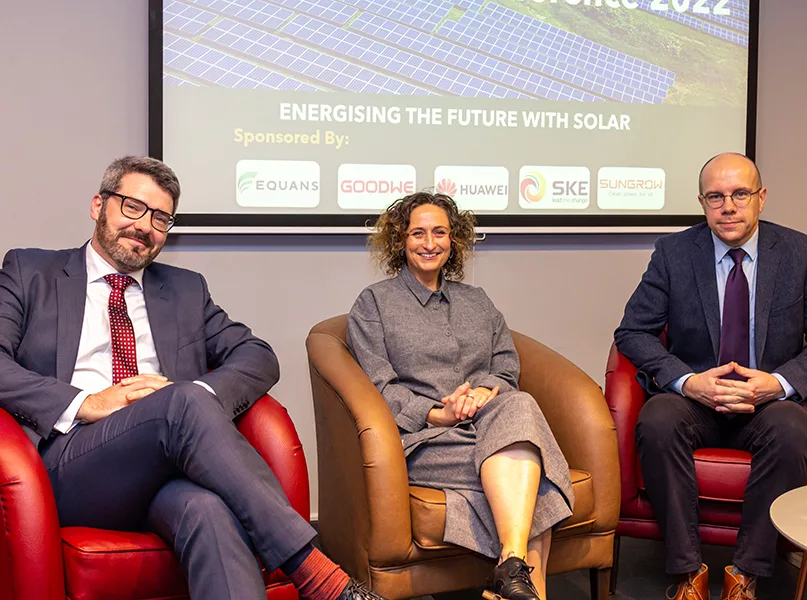
How does the Irish Solar Energy Association promote solar as a leading renewable energy technology that will push the energy transition forward, and contribute to a clean economy?
CB: It comes back to our mission and values as an association. We try to pursue policies that optimise outcomes for society, be constructive in our contributions to policy, and propose concrete measures that are grounded in data. We also try to be holistic in our views, so we obviously represent solar as a technology, but also as a constituent of the wider energy value chain, and we try to take that broader approach in our contributions.
At all times, we emphasise interventions to aid solar cost reduction. That wider framework has been very helpful as we’ve gone through our mission of engaging, educating, and encouraging best practice. We’ve been working hard with other stakeholders to try and remove barriers and encourage the policy regulatory framework amenable to solar.
There’s a diverse range of players across government, politicians, regulators, network agents, state agencies, and international investors, so it’s a big group. Key to that engagement is funnelling input from our members, using our working groups, the board, and other avenues to ensure we’re representing and capturing the views of the solar industry.
They don’t always agree with each other, but we do our best to be representative of what will drive good results for Ireland and renewables deployment. We ensure solar is prominent through the education work streams, commissioning interesting research into the industry to ensure the solar viewpoint is evident.
We’re active in the media and very visible at conferences and other events. Basically, we’re always looking for opportunities to spread the solar gospel. Finally, it’s incumbent on us to scale responsibly, hence the need to develop a suite of best practices.
Could you describe how solar will meet the Irish government’s target of providing at least 8GW of Ireland’s electricity capacity by 2030?
CB: One of the strengths of solar is that you have a lot of vectors to deliver capacity, and you don’t need a lot to go right for the numbers to start getting pretty big. As mentioned, we’re on track to be close to 1GW installed by the end of this year, which suggests a really fast rate of change. In terms of the pathway to the target, we have markets across the utility, residential, and commercial scales.
We’ve now had three RESS auctions awarding a substantial amount of capacity. The utility scale pipeline is now at 10GW. The key is delivering and maximising that capacity because with grid connection timelines, we are running the risk of it not being delivered on time. In addition, you have the rooftop sector, which is moving very fast, where microgeneration has been one of the real success stories.
This year, we’re on track to install 34,000 microgeneration systems; last year, we installed 17,000, and the year before, we installed close to 7,600, so the industry has doubled in each of the past two years.
Something else that’s beginning to develop is the commercial space, which is quickly moving from kilowatts to megawatts. There’s a phenomenal level of industry interest in taking part in the solar and broader energy transformation. If you add those numbers up, what you find very quickly is that there are very credible scenarios where you get to those kinds of figures the government are talking about, but it will come down to delivery and implementation.
There are probably areas of development that we as a country need to progress.
“There’s a phenomenal level of industry interest in taking part in the solar and broader energy transformation”
Conall Bolger, CEO, Irish Solar Energy Association
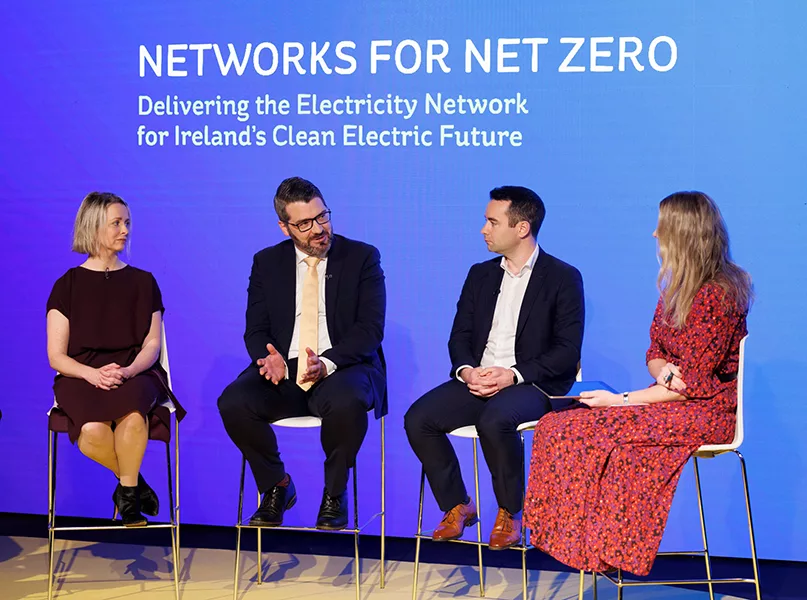
How do you see solar energy in Ireland developing over the coming years?
CB: Beyond scaling, the Irish solar industry is changing in a lot of ways. We are seeing a variety of business models, and we’re seeing scale at the same time, so it’s a very exciting time.
A lot of projects from the first RESS auction have also gone on to sign corporate power purchase agreements (PPAs). It’s quickly becoming extremely commercially sophisticated, with Meta, Microsoft, and Google all signing substantial corporate PPAs.
That commercial sophistication belies the relative immaturity of the market. We’re even looking at behind-the-meter corporate PPAs, which again are happening very rapidly in this market. The policy frameworks are currently under discussion with the regulator and policymakers for private wires, which has been a long-standing missing piece of our decarbonisation jigsaw, as well as hybrid sites with multiple technologies behind a single connection point on one site.
It really comes back to the nature of the technology; you can use solar panels in a lot of different contexts. Users can generate their own power, you can have large-scale projects, and you can pair solar with batteries; those different use cases are going to be key tools in Ireland’s decarbonisation journey.
Finally, what are the Irish Solar Energy Association’s key priorities in order to fully decarbonise Ireland’s electricity system?
CB: We’re blessed with an extremely strong project pipeline, with over 10GW actively in development from planning through to projects being built along with burgeoning residential and non-residential sectors.
If Ireland was to deliver on its targets in terms of watts per capita, we would be one of the leading markets in Europe and the world, so what we’re trying to do is really ambitious.
However, there are key areas that need addressing and measures that we as a market have to undertake if we’re really going to stand out. Grid infrastructure is probably priority number one for the Irish solar industry. At a very fundamental level, it takes too long and costs too much. The price of renewables in Ireland is too high, our auctions are expensive, and there are domestic policy reasons contributing to that.
For a long time, in partnership with our colleagues in other renewable technologies, we’ve been calling for a cost of renewables task force. This is a strategically significant and important industry, so we need to get serious about it. We need to look at driving those costs out, and a lot of those costs are generated by state bodies. We as a state can make decisions to address that situation.
Aligned with the cost of infrastructure, we need to think about clever ways of unlocking capacity in the short term. That’s about implementing private wires, hybrids, and common-sense changes that move the agenda forward and are relatively simple, rather than getting bogged down in the minutiae of longer-term issues.
Essentially, it’s about accountability and implementation. The fact is that, at a high level, we like the plan. The industry and most bodies have bought into the government’s targets and the climate action plan, but now it’s about actually delivering on it, ensuring there’s accountability, that we’re implementing it clearly, and that there are the appropriate resources in the right places at the right time to push the plan through. For example, we believe there are a few tweaks to the auction framework that could really help make sure the capacity that is awarded gets delivered.
We want a thriving auction, working alongside a thriving corporate PPA market. We want to ensure that when a contract is awarded, it gets delivered, because the goal is ultimately green kilowatt hours on our system. Having a drop-off between an auction and projects actually getting delivered is not a helpful outcome.
